Calcium is one of the most coveted nutrients of all ages and it’s also one of the most misunderstood by the general public leading people to think that dairy-free sources of calcium aren’t the best option.
Unfortunately, the food industry has also convinced the American public that the only way to obtain this crucial mineral is to consume the milk of a cow, another species.
The most misfortunate myth out there, however, may be that most people believe calcium is the most important nutrient you need when looking to improve bone health and maintain strong bones to prevent conditions such as osteoporosis.
But like most nutrients, calcium doesn’t work alone in the ways it helps improve human health.
Why Dairy Doesn’t Equal Calcium and Strong Bones:

A variety of vitamins and minerals must be consumed, absorbed, and utilized appropriately in order for a person to truly be healthy.
Dairy consumption doesn’t do that, and it can actually lead to calcification of the bones because the calcium in milk tends to disrupt the body’s natural mineral balance.
Dairy can also lead to malabsorption issues in both adults and children because dairy tends to be difficult for people to digest which can lead to problems digesting and absorbing other minerals when cow’s milk products are consumed.
What’s also important to consider is how crucial the role that Vitamin D and other minerals aside from calcium, such as magnesium, play in bone health.
Calcium is important but not just for bone health; calcium is also important for blood pressure regulation, heart health, brain health, and even maintaining an alkaline/acidic balance in the blood.
In fact, a study performed at Yale University found that within 16 countries, people who consumed the most dairy products and animal-based foods had the highest levels of osteoporosis. Clearly, cow’s milk doesn’t equal strong bones like we have all been led to believe.
Lucky for all of us, we don’t need cow’s milk and regular dairy products to get enough calcium!
How to Get Enough Calcium on a Dairy-Free Diet:
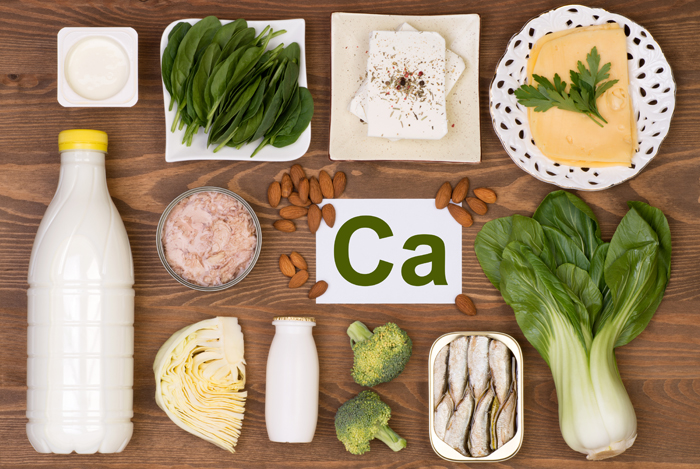
The current USDA recommendations for calcium intake ranges from 800 milligrams per 1200 milligrams. Women and children under the age of 25 will need anywhere from 800 – 1000 while men and women in their post child-bearing years or early 30’s will need anywhere from 1000 – 1200 milligrams.
Whether you’re a dairy-free eater or not, calcium is very easy to find in natural foods and consume in a plant-rich diet. You don’t need a supplement or fancy product to help you get strong bones either. In fact, calcium is a mineral which means it grows in the soil, not cow’s or synthetic vitamins.
You might also like to know that most cows are fed synthetic sources of calcium through their feed which means, we could save our time, money and resources by just going straight to the source: plants! Plants come from mineral-rich soil, especially if you purchase organic foods.
Cow’s milk also only has 300 milligrams of calcium per serving, which is not that much more than some of the other sources you’ll find down below.
Here are some of the best sources of calcium you can get without ever touching dairy. What’s even better is that these foods provide ample amounts of vitamins and minerals to improve your overall nutrition and bone health!
1. Leafy Greens
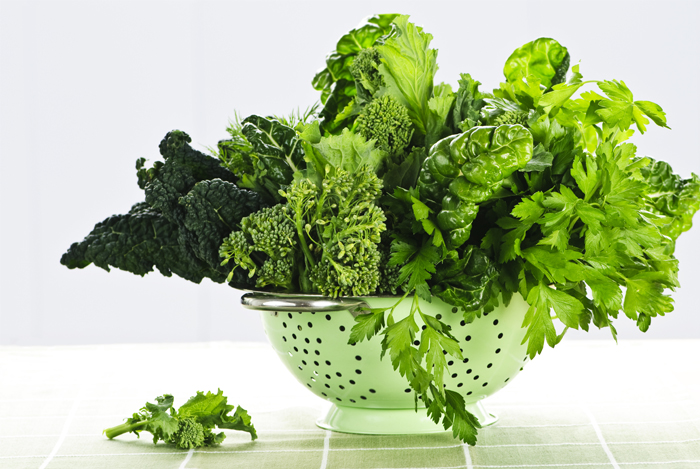
Not all leafy greens are created equal in their calcium content, but most dark green leafy vegetables are a great place to start when you’re looking to eat the most nutrient-dense sources of calcium. Collards, chard, kale, and spinach are all good sources, but you’ll want to be sure you cook them first since it helps the absorption process.
As a bonus, leafy greens are also very high in magnesium and non-heme iron so they improve your uptake of overall minerals and ensure you’re taking in Vitamin C which helps with the absorption process of iron and other minerals like calcium even further.
Here are the contents of some of the most popular types of leafy greens (cooked, not loose or raw):
- Collards: 210 milligrams per ½ cup
- Kale: 205 milligrams per ½ cup
- Mustard Greens: 194 milligrams per ½ cup
- Bok Choy: 190 milligrams per ½ cup
- Turnip Greens: 104 milligrams per ½ cup
- Spinach: 100 milligrams per ½ cup
Important Note: Oxalic acid is a natural nutrient found in plants, especially spinach, rhubarb, chard, and beet greens. It binds with the calcium in those foods and reduces its absorption, so don’t rely on spinach and chard alone to get enough calcium.
Cooking reduces the oxalic acid content of greens, but it’s still best to eat a variety of greens instead of relying on one source.
You can spread your greens out throughout the day if you’d like to take in more nutrients throughout the day instead of relying on getting a large dose of calcium at just one meal from greens. It’s also fine to eat them raw, just be sure to eat some cooked too!
2. White Beans
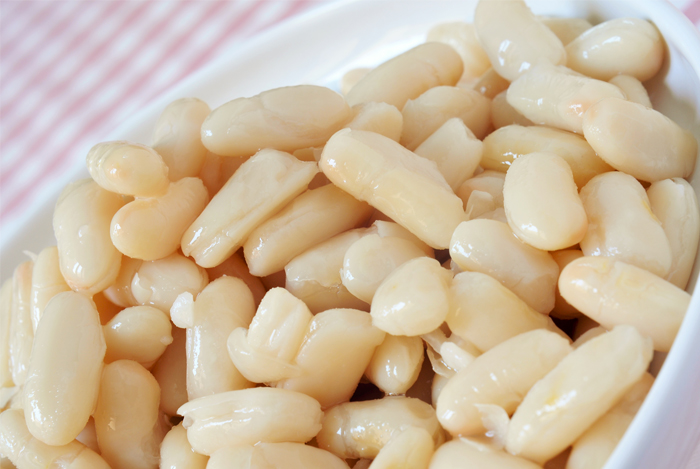
Navy beans and other varieties of white beans are an exceptional source of calcium with 120 milligrams per serving. They are also very high in magnesium, iron, potassium, zinc, and some B vitamins.
White beans tend to be easier to digest for some people rather than larger beans, such as kidney beans. They also have a delicate, tender texture with a mild and nutty flavor making them delicious in soups or added to rice and salads.
One easy way to increase your calcium intake in one meal is to pair white beans with collards or kale in a slow cooker with some onion, garlic, and red lentils (another great source of protein). This hearty stew is packed with minerals and vitamins which will nourish your bones and the fiber content in this meal will keep you full for hours!
Soybeans are also a good option if you’re looking to eat more beans. They contain 190 milligrams of calcium per serving and are a complete source of protein.
3. Dried Figs

This is one source that’s easy to overlook when you’re thinking about where to get your calcium from, but figs are one of the most nutrient-dense foods you can eat! Figs are not only a great source of fiber, but they’re also packed with calcium, containing 135 milligrams for 5 figs!
Figs are also high in other bone-building minerals, such as magnesium which is important for overall bone strength, growth, development, and many other important functions in the body. Figs even contain iron and are one of the best fruits you can eat for improving your digestion and mood.
Tips: Buy Black mission figs when you can since they’re richer in antioxidants than regular, but any dried fig variety will provide you with the same amount of calcium.
Figs can be also used in place of any recipe that calls for dates! They’re similar in size, texture, and flavor to dates, and they just need a quick soak before use to soften them up if you purchase them in dried form.
4. Tofu

If you like tofu, then great! It’s packed with calcium and is a complete source of protein. Tofu contains 350 milligrams of calcium per ½ cup serving and soy milk is another great option if you’re not into tofu.
Tofu takes on the flavor of whatever you cook it with, so if you’re new to using it, cook it up with some of your favorite seasonings and sauces, and saute it in a pan, just like you would animal-based products.
5. Chia Seeds
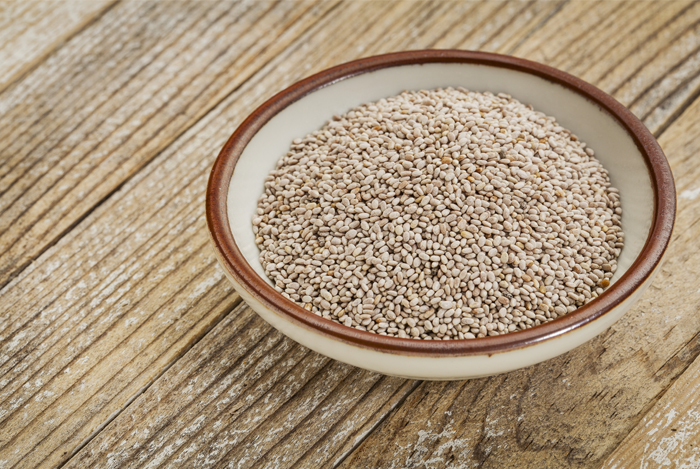
What can’t chia seeds do?
Chia is packed with not only protein and iron, but also calcium and magnesium, making it a wonderful food to eat for bone health and strength! Chia is also rich in fiber and Vitamin E, plus it’s a great source of zinc, B vitamins, and omega-3 fatty acids. Chia seeds contain 300 milligrams of calcium per 1.5 ounce serving, which is about 2.5 tablespoons.
Since chia is very high in fiber, space your chia seeds out throughout the day, such as having 1 tablespoon in a morning smoothie or some oatmeal and another tablespoon or so in the afternoon.
Try making chia pudding or a homemade salad dressing with chia seeds, or just toss them into your dinner entree.
They’re tasteless and useful for replacing eggs in baking, so chia seeds also have a benefit of being incredibly useful to use in the kitchen.
See more science-backed benefits of chia seeds here if you still need more convincing reasons to add these superfood seeds to your diet!
6. Non-Dairy Milks
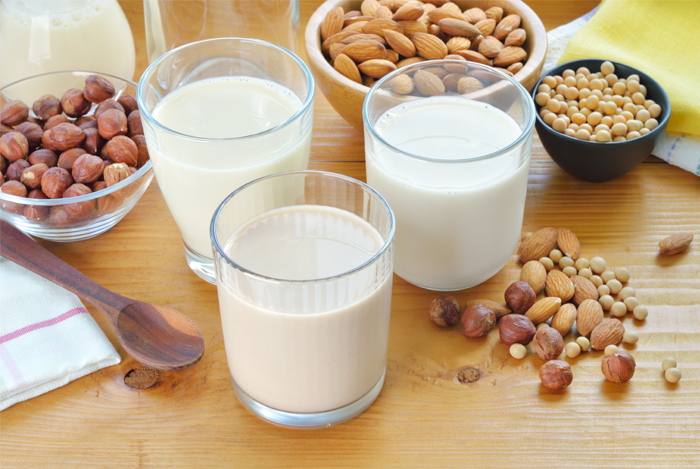
Most all non-dairy milk varieties that are available on the market now have 50% more calcium than cow’s milk. While it’s true that these are fortified with calcium during processing (just like cow’s milk is), they are still a wonderful option if you’re looking for easy ways to improve your calcium intake in similar ways that you would consume milk.
So pour some unsweetened almond or cashew milk onto your oatmeal, add it to your coffee, or use it in a smoothie.
There are limitless ways to use non-dairy milk varieties and most products range between 300- 500 milligrams of calcium per serving!
Read labels to double check and be sure to choose unsweetened or light options whenever you can to avoid the intake of added sugars.
7. Tahini or Sesame Seeds
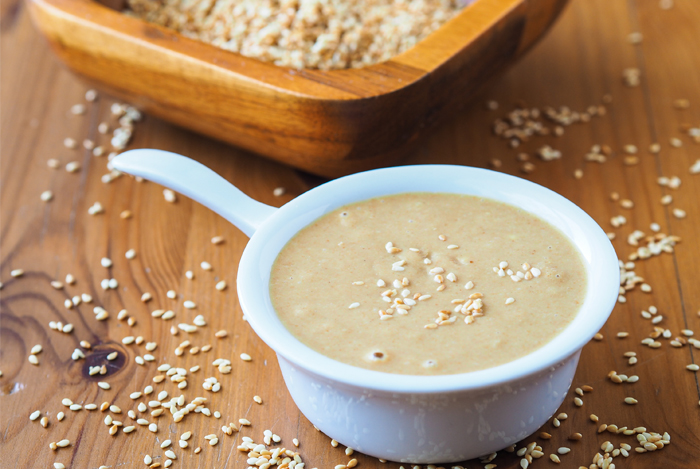
Sesame seeds are high in calcium for a seed, although not as high as chia seeds are. Sesame seeds have 180 milligrams of calcium per 2 tablespoons, which is about the same as a cup of yogurt or piece of small piece of cheese.
Tahini, also known as sesame seed butter or paste, is another great way to consume plenty of dairy-free calcium each day.
Tahini makes a fantastic addition to homemade salad dressing or salads because it has savory, nutty, and unique flavor that’s easy to love. Tahini has the same amount of calcium has 2 tablespoons of sesame seeds, but check labels to make sure that your tahini is made with just sesame seeds and not a lot of additives such as salt, sugar, and oil.
Tahini is also a great source of meat-free iron and protein, believe it or not!
8. Almonds

Almonds are so good for you!
They’re not just great for your heart but also your bones too. Almonds are high in calcium, (for a nut), and contain 90 – 95 milligrams per serving (¼ cup), depending on the variety. There are roughly 22 almonds per 1 ounce of almonds which would provide you with even more calcium, with up to 120 milligrams found in most varieties.
Almonds are also a great source of Vitamin E and magnesium, plus fiber and protein too. You can eat raw or dry roasted almonds or use roasted almond butter or raw almond butter.
Either way, this nut is a fantastic addition to your diet and makes for a delicious way to increase your calcium needs. So add some to your next breakfast, lunch or dinner, or just eat them as part of a healthy snack!
9. Broccoli

Believe it or not, you can even get your calcium from broccoli! Broccoli contains 62 milligrams of calcium per cup of cooked broccoli, so don’t rely on broccoli alone but be sure you make it a part of the vegetables you consume throughout the week. Every little bit counts!
Tip: To be sure you’re taking in the most nutrients from veggies like broccoli when you’re cooking, be sure you don’t over-boil them and if you boil them in water, be sure to consume the liquid that they cook in.
Minerals, such as calcium, can get lost during the cooking process under especially high levels of heat, so one way to improve your absorption of all nutrients, including calcium, is to just lightly steam them to soften before they get soggy and overcooked.
10. Blackstrap Molasses

While this food is high in sugar, it’s also one of the most nutrient-dense sweeteners out there because it’s literally packed with minerals!
One tablespoon of blackstrap molasses is loaded with iron, magnesium, and calcium to boot! It contains 200 milligrams of calcium per tablespoon, which is about 20% of your daily needs. That same tablespoon will provide you with 4.5 milligrams of iron, right over ¼ of your daily needs of iron.
Blackstrap molasses is rich in flavor, so you won’t want to consume too much at once and overpower your dishes with it.
Since molasses is also high in sugar, it’s smart to use this source of dairy-free calcium very sparingly in your diet. Still, having a teaspoon or tablespoon of blackstrap molasses in some oatmeal or a smoothie is a great and very natural option to get your sweetness and minerals in one dose!
As you can see, it’s easier than ever to get enough calcium on a dairy-free diet, so what are you waiting for? Add these 10 healthy dairy-free options to your meals this week and start choosing something other than cow’s milk at the store.
You’d be surprised how easy it is to shop dairy-free if you’ve never done so, and most people that make the switch to non-dairy living never go back to using cow’s milk products again!
Want meat-free protein options to go along with your dairy-free calcium foods at mealtime? Give these options a try and see what you think!
The post How to Get Enough Calcium on a Dairy-Free Diet appeared first on Nutrition Secrets.
http://www.nutritionsecrets.com/how-to-get-enough-calcium-on-a-dairy-free-diet/
No comments:
Post a Comment